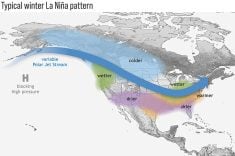CONQUEST, Sask. – This equine centenarian came through the winter in good shape, eats well and gets plenty of fresh air.
Daisy is cared for every day by Art Cole, 90, a human who is younger in relative terms than the horse. Cole bought the part Morgan, part Appaloosa mare from a neighbor in 1983 for $500. Daisy, already 25 at the time, is now 41.
Horses commonly live to about 25 years, although the Guinness Book of Records notes the oldest it has documented was a 51-year-old former Italian army horse that died in 1960. Animal husbandry books have complicated formulas for equating horse to human years, but the rough ratio is one to three, placing Daisy well over 100 in people time.
Read Also

Canadian Food Inspection Agency extends chronic wasting disease control program consultation deadline
Date extended for consultation period of changes to CWD program
The horse was a gift for Art and Isobel Cole’s granddaughter, who was then 11. Now a 27-year-old mother of three, Megan Kokesch doesn’t get out to see her old 4-H partner as much.
“She was the first horse I rode,” said Kokesch. “I did every weekend riding with a girlfriend.”
Kokesch and Daisy won ribbons together in 4-H classes and the horse was also loaned out for sheepdog trials since she was calm around other animals.
Daisy’s personality is as much a claim to her fame as her age and health.
“She’s a very gentle horse,” said Kokesch. “But she was very tricky about trying to catch her. I’d stick a rope behind my back or in my jacket and go out to the pasture with a pail of chop.”
Kokesch has not ridden the horse in a couple of years but she has had her four-year-old son on Daisy.
“I worry about her. Maybe I’m overprotective but I wouldn’t want to hurt her back.
“Once you get on her she’ll go. She has still got her energy and spunk. She’ll do. She’ll try to trot. She always had a fast gait.”
Kokesch also remembers being too small to scramble up onto Daisy bareback. The horse solved the problem. It leaned its neck down, allowed her to get a grip, then tossed her head, bringing the child up as well.
The Coles have a fondness for horses and especially the mare. They farmed with horses in the 1930s and 1940s. Isobel drove 12 horses on the cultivator during the Depression years and Art talks about the practicalities of carrying pails of chopped oats for the dozen in the barn.
“Then we’d have to get the wheelbarrow and the scraper,” he said with a mischievous grin.
Art maintains he’s not retired as a farmer yet. Besides Daisy, he looks after her adult foal Ginger and another horse Lady – all pets.
“I don’t know what for. To give me something to do.”
The Coles haul out old photo albums showing bygone teams and Daisy and Megan. They agree Daisy is one smart horse. Added Isobel: “She’s the kindest thing. I’ve never seen her raise her foot to anybody.”
Their son Ray Cole, Megan’s dad, has a slightly different view. The horse is spoiled, he said. The family tells of the days Daisy and Ginger used to come into the farmhouse kitchen to eat carrots. But Isobel said they had to stop that because the last time it happened, the kitchen took a beating from the size of the horses.
Kids from Conquest used to come out asking if they could ride Daisy and her original owner came over for one last ride in 1991 when he was 86 and leaving the area, said the Coles.
As for Daisy, a pail of chop, some water and companionship make her a happy horse.














